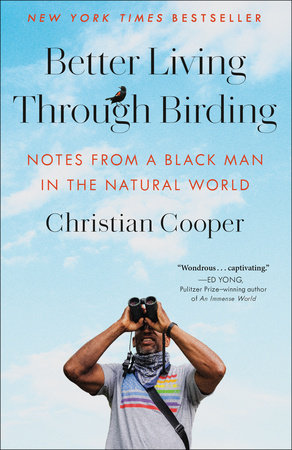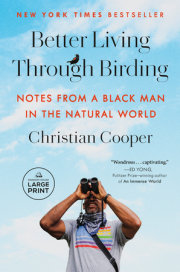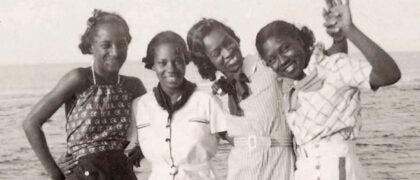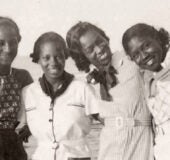1
An Incident in Central Park I am a Black man running through New York’s Central Park. This is no leisure run. I’m not pushing for a new personal best, though my legs pump in furious rhythm. I’m running as if my life depends on it. And though my heart pounds, it’s as much out of mounting panic as it is cardiovascular stress. I know what this looks like. My sneakers are old and muddy, my jeans in need of a good washing, and my shirt, though collared, could at best be described as unkempt. I am a Black man on the run. And I have binoculars.
This is not how this evening was supposed to unfold. But all it took was a brief exchange of words to put me in flight. Twilight is racing along the horizon, and I’ve got half an hour of light left at best. As the sun sinks behind trees wreathed in its glow, so, too, does a feeling of desperation in the pit of my stomach. I’m running out of time.
I check the alert on my phone again and curse myself for turning it off for the entire workday. I’d faced several grueling tasks with hard deadlines and had found the constant vibrating notifications from the Manhattan Rare Bird Alert too indiscriminate (“rare” being rather loosely defined by some contributors) and too distracting during working hours. I preferred to do my birding early in the morning anyway. Then I would head directly to the office, where my colleagues have grown accustomed to my business-questionable attire this time of year (functional and subject to deferred laundering; the demands of my spring migration schedule don’t permit much else). So it wasn’t until 6:00 p.m. that I turned my phone on and saw the text from Morgan:
“Are you going to go see the Kirtland’s Warbler?”
Amusement at what obviously had to be a prank quickly morphed into disbelief as I read the chain of alerts that had preceded it. “Oh my God, oh my God, oh my God!” I sputtered, snatching the binoculars off my desk and hurtling out of the office without explanation. At least one co-worker would tell me later that he was certain someone had died.
Now, having sprinted from my office in midtown to the west side of the park near the Reservoir, I slow as I near where I think I need to be. After a few minutes a sinking feeling settles in that I must be in the wrong spot. But as I round a bend in the path, I see a mass of people—nearly all of whom I recognize—and know I’ve found the place.
Birding Tip
The fastest way to find a widely reported rarity is to look not for the bird but for the coagulation of birders already looking at it. Reading my stricken expression and ragged gasps as the cocktail of panic and exertion that they are, Mike peels off from the crowd and intercepts me. “Breathe,” he says, calm, compact, and dryly British as always. “It’s still here; we’re looking at it right now.” And with a little help from my friends, I find the right spot in the right tree; lock onto the motion among the leaves; and raise my binoculars with hands shaking with anticipation. A bird, slate blue and yellow and smaller than a sparrow, moves from branch to branch with a pump of its tail. I see a unicorn, come alive before my own eyes.
In order to truly appreciate that moment, you must first understand something about this particular bird. The rarest songbird in North America, Kirtland’s Warbler is a creature even more unlikely to be spotted in Central Park than the gay Black nerd with binoculars looking up at it. It nests strictly in jack pines of a certain age, habitat requirements so specific that in all the world there are only about six thousand of the birds, restricted to a breeding range that consists almost entirely of a small patch of Michigan. Kirtland’s Warblers return there every spring from their wintering grounds in the Bahamas, traveling hundreds of miles to do so. Yet in that routine annual journey, one of these tiny bundles of feathers happened to wander a bit off course, or maybe, like me, this rare bird yearned to taste life in the big city, where freaks of nature of every kind are welcome. It would end up somewhere in the eight hundred acres of Central Park, a tiny thing flitting behind the leaves of the park’s eighteen thousand trees teeming with a million or so other avian visitors, including other warblers from which, to the untrained eye, a Kirtland’s is indistinguishable. In the words of Captain James T. Kirk, “Finding a needle in a haystack would be child’s play by comparison.”
Enter the birder Kevin Topping. He happened to be at the right place at the right time, but though luck plays a part in any sighting, there’s so much more to getting the bird than that. A birder is alert to the presence of creatures that “civilians” would likely never even notice; they’d just walk right past. A birder’s eyes lock onto a particular kind of motion in the trees, distinct from that of leaf movement in the wind, or to a particular shape that, motionless, is meant to camouflage into its surroundings. And a birder’s ears never turn off, akin to a police scanner that snaps the attention into focus and sends one springing into action when, from amid the constant chatter, an urgent message (a distinctive bird vocalization) comes through. Then there’s the accumulated knowledge base that an experienced birder brings to bear—a familiarity with what to watch for in what habitats, and an almost intuitive grasp of the subtle details of behavior, of plumage, that let you sort one kind of bird from another. Kevin Topping not only had the skill to find the bird but knew enough to know what he was looking at, and he had the presence of mind to get the word out to the broader birding community in a timely fashion.
That’s how, for the first time in history, a Kirtland’s Warbler was recorded in Central Park. It’s as if you stepped into your backyard and saw a wild tiger prowling your lawn, or as if you looked over the side of a boat to catch a wink and smile from a mermaid before she dove beneath the waves. Or as if a real live unicorn stepped out of the forest.
This, then, is the seventh of the Seven Pleasures of Birding, and perhaps the greatest thrill of the pastime:
Seventh Pleasure of Birding: The Unicorn Effect It’s the thrill of seeing at last for oneself a creature that until then has existed only in the imagination. But while number 7 is the high-octane moment, other pleasures make birding a joy for almost anyone, as I have tried to tell my feckless friends; they wonder why I abandon them every year in May, the peak of Central Park’s spring songbird migration, when I become an early-rising, sleep-deprived mess of a man instead of carousing with them. After one too many attempts to explain, I codified those aspects of the birding experience into the Seven Pleasures of Birding, for ease of dissemination to the uninitiated, and of those seven pleasures, this comes first and foremost:
First Pleasure of Birding: The Beauty of the Birds If you’ve never seen a male Scarlet Tanager in full breeding plumage—a bird of such incandescent hue, set off by jet-black wings and tail, that it makes a stoplight look dim—then a knock-your-socks-off experience awaits you. And that’s just the beginning of the show, from the gaudy, Technicolor riot of a Painted Bunting to the serene, pristine grace of a Great Egret; from the effortlessly soaring majesty of a Golden Eagle to the fierce frenzy of a hummingbird; from the bold color blocks of a Red-Headed Woodpecker to the exquisite nuance of pattern and muted tones of a Lincoln’s Sparrow . . .
But most people don’t realize the reasons why, of all the spectacular creatures with which we share this planet, birds captivate us as no others can.
What makes birding such a phenomenon? Why not “mammaling” or “insecting”? Certainly those pursuits have their adherents, as the thousands who visit Africa on safari or who catalog butterflies can attest. And in fact, there’s a large degree of overlap among all these obsessions, counting myself as one of the multi-obsessed; once you tune in to one aspect of nature, you eventually become aware of the whole connected network of life around us.
Birding, however, occupies a sweet spot of accessibility: The variety of birds, no matter where you are around the globe or what kind of place you’re in—city, suburb, country; mountains, woodland, field, swamp, shore, or out to sea—greatly exceeds the limited number of species of mammals in the same area; and many of those mammals are nocturnal and/or hidden beneath the soil or under the sea, restricting observation. Bugs, on the other hand, present the opposite problem: The crazy profusion of insect species is nigh impossible to master, or else, in temperate climes in the wintertime, there are almost none at all. With birds, no matter the time of year, there’s always something to see.
Copyright © 2023 by Christian Cooper. All rights reserved. No part of this excerpt may be reproduced or reprinted without permission in writing from the publisher.







